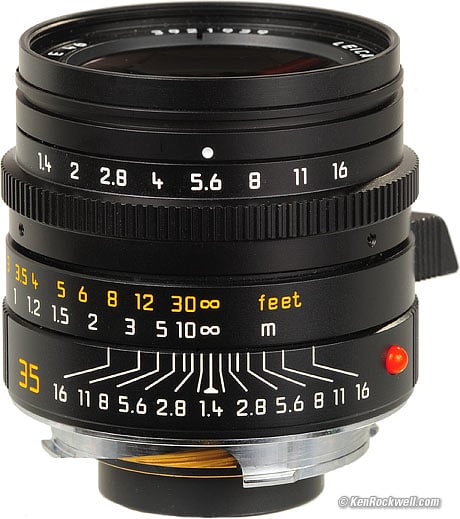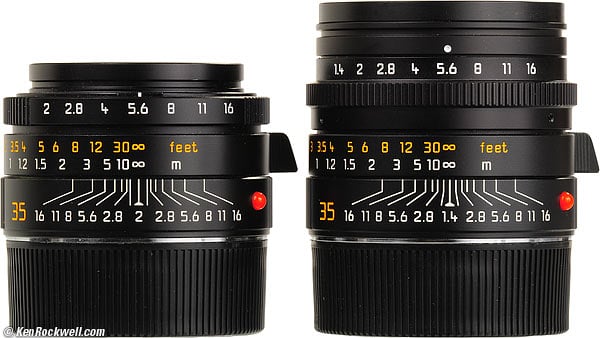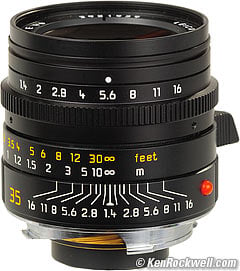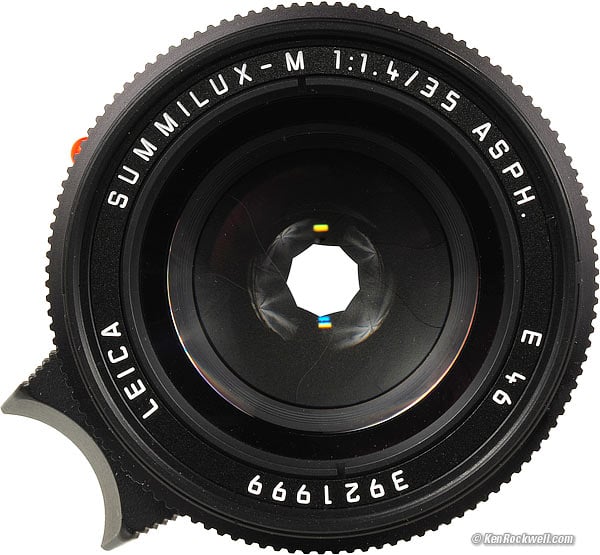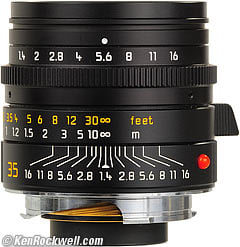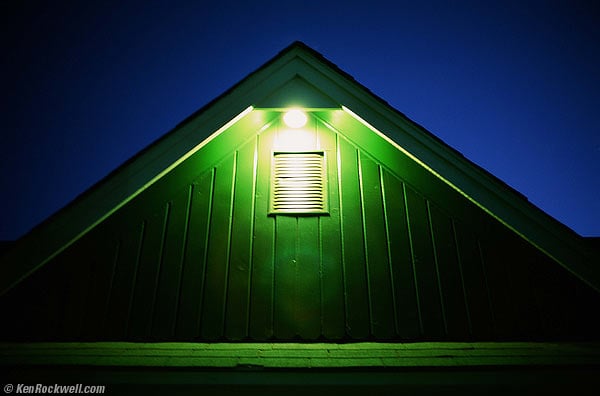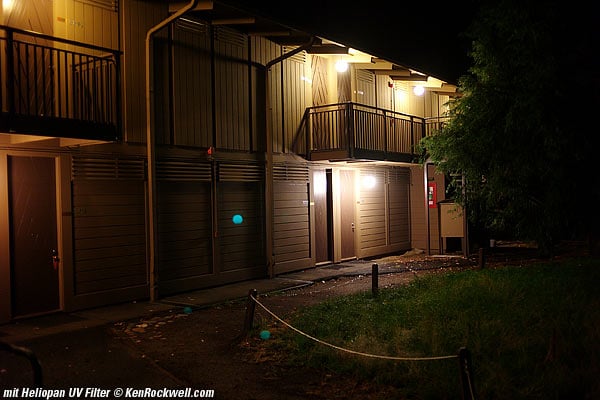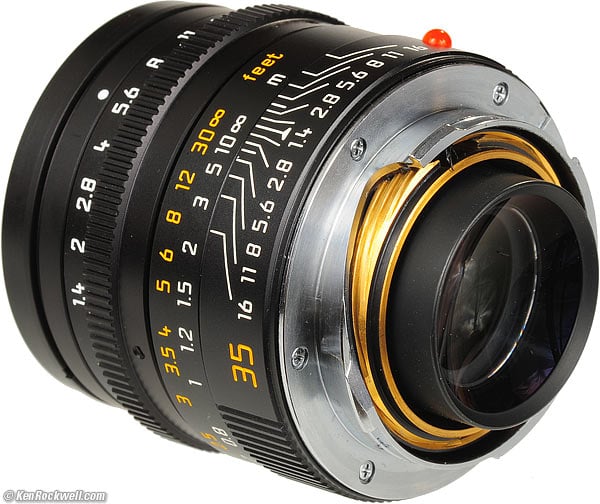Home Donate New Search Gallery Reviews How-To Books Links Workshops About Contact
LEICA 35mm f/1.4 ASPH
SUMMILUX-M (1994-2010) new 2011 version
© 2011 KenRockwell.com. All rights reserved.
Intro Specs Performance Usage Compared Recommendations
LEICA 35mm f/1.4 ASPH (46mm filters, 11.4 oz./323g with hood, about $4,500 used), twice life-size. enlarge more. This free website's biggest source of support is when you use these links, especially this link directly to it at eBay (see How to Win at eBay), or maybe at Amazon. It helps me keep reviewing these oldies when you get yours through these links, thanks! Ken.
Oktober 2011 LEICA Reviews LEICA Lenses Recommended Lenses All Reviews
NEUE: LEICA SUMMILUX-M 35mm f/1.4 ASPH with floating element group replaces this lens as of 2010.
See also LEICA SUMMILUX 35mm f/1.4 (1960-1995).
| Optics: | |
| Mechanics: | |
| Ergonomics: | |
| Usefulness: | |
| Availability: | |
| Overall: |
Ideal Uses: Journalism, and any place where you absolutely need f/1.4 instead of f/2.
Not for: The LEICA 35mm f/2 is as good, and usually a better choice unless you absolutely need f/1.4. This 35mm f/1.4 will block part of your finder, while the 35mm f/2 won't.
Example Photo Galleries
Yosemite (October 2002).
Volcano Country (May 2009).
Sample image (5MB JPG).
Introduction top
Intro Specs Performance Usage Compared Recommendations
The LEICA 35mm f/1.4 SUMMILUX-M is a super-sharp, super-fast general-purpose lens intended for journalists. Shoot it at f/1.4 and it's sharper than most other brand 35mm lenses at any aperture. I can shoot ISO 50 Velvia at night at 1/3 of a second hand-held at f/1.4, and get great results. With lenses as fast as this, who needs fast ISOs like ISO 100?
If you're a journalist, you'll trade anything to get f/1.4, but for most people, the 35mm f/2 lens does everything as well doesn't block the viewfinder.
Get this lens if you're willing to trade size, weight and price in exchange for a one-stop gain in speed. This 35mm f/1.4 will block the lower right corner of your viewfinder, which to me is a bother, and has very dark corners if you actually use f/1.4.
LEICA's published specifications lie. This f/1.4 lens weighs 10.815 oz (306.7g), far more than the 8.8 oz (250 g) claimed by LEICA. Compare this to the 9 oz. (255 g) claimed for the 35mm f/2, which is accurate.
LEICA 35mm f/2 ASPH and LEICA 35mm f/1.4 ASPH. enlarge.
Format
I'm shooting and testing these lenses on full-frame digital and film. I'm ignoring the half-frame M8, which should blow over as did Nikon's half-frame DX cameras.
Full frame digital? Easy! I have my lab scan everything as they run my film, so I already have every shot backed up at high-resolution (50MB) on DVD when I pick up my film. They do this cheaply enough that I have everything scanned as it's processed. They're more than happy to do the same for your film, too, by mail.
I load these DVDs into my system faster than fiddling with memory cards, and I'm done, and I get far higher resolution than if I wasted my time with an M8.
Actual Size
Presuming you have a standard 106 DPI monitor, this is the actual size of the 35mm f/1.4. It's only two inches (5cm) long, smaller than small SLR lenses:
LEICA 35/1.4, actual size. enlarge.
All of the illustrations in this review have been enlarged as not to be dwarfed by the test.
History
|
I use Adorama, Amazon, eBay, Ritz, B&H, Calumet, J&R and ScanCafe. I can't vouch for ads below.
|
LEICA has always called its f/1.4 lenses "SUMMILUX," regardless of focal length or optical design. Thus SUMMILUX is a meaningless trademark, not any indicator of lens age, quality or design. All these lenses are sold as "SUMMILUX" lenses.
1961 ~ 1990: 35mm f/1.4 SUMMILUX-M (11 870)
The first 35mm f/1.4 SUMMILUX-M (11 870) had 7 spherical elements in 5 groups. It's a conventional double-Gauss design.
It weighs 245g and is only 38mm long.
In the beginning, it also came in a version with additional finder optics (11 871) for use on the M3.
By itself, this first 35/1.4 focuses to 1m, and with the M3 reducing optics, focuses to 0.65m.
The first version, up to serial 2,166,700, used a bizarre 41mm filter, then was changed to use series VII instead. Neither size is easy to find today.
The first version used the 12 586 hood, and the latter uses the 12 504 hood.
It has come in silver and in black.
An optical advantage of this first version 35mm f/1.4 is that its mostly symmetrical design produces no distortion, unlike the slightly stronger distortion (bending of straight lines) of the newer aspherical versions.
This first version is pretty soft at f/1.4 and can't use easy-to-find filters, which limits its appeal, but its lack of distortion and having the same sharpness as the current lenses stopped down can make it a winner.
1990 ~ 1994: 35mm f/1.4 SUMMILUX-M Aspherical (11 873)
LEICA made a 35mm f/1.4 SUMMILUX-M Aspherical with 9 elements in 5 groups.
This first aspherical version had two aspherical surfaces, and concave (inward-curving) front and rear elements.
It was discontinued after only four years.
1994 ~ today: 35mm f/1.4 SUMMILUX-M ASPH (11 874, 11 883)
This current 35mm f/1.4 SUMMILUX-M ASPH came out in 1994, and 15 years later, is still LEICA's current version.
It has only one aspherical surface.
It also has concave (inward-curving) front and rear elements.
Specifications with commentary top
Intro Specs Performance Usage Compared Recommendations
Name
LEICA calls this the LEICA SUMMILUX-M 35mm f/1.4 ASPH.
Part Nr. 11 874.
"SUMMILUX" means nothing except f/1.4 , and "ASPH" is short for aspherical.
Focal Length top
Actual (design) Focal Length: 35.6mm.
35mm equivalent: 35mm. Duh, this is a full-frame 35mm lens.
Digital Equivalent: 35mm. Duh, I shoot full-frame have all my film scanned direct to digital.
Digital Resolution: 25MP when shot on film.
Equivalent on the LEICA M8 (half-frame): 50mm (actually 47.3mm).
Equivalent on the Epson R-D1x (half-frame): 54mm.
Angle of View (full-frame 35mm) top
63º Diagonal.
54º Horizontal.
38º Vertical.
(less on lesser formats.)
Optics top
9 elements in 5 groups.
One ground aspherical surface.
Multicoated.
Diaphragm top
9 blades, perfect!
LEICA 35mm f/1.4 ASPH at f/5.6, 2.5x life-size. enlarge.
Blades are straight to f/2, inwardly curved from f/2.4 ~ f/8, and straight from f/9.5 ~ f/16.
Stops down to f/16.
Half-stop clicks.
Filter Thread top
46mm.
Germans call this E46 and 46E, but it's the same standard 46mm (0.75mm pitch) filter available everywhere.
46mm is larger than LEICA's standard 39mm, but it's the same as the Contax G system, the Zeiss 21mm lenses and LEICA's other larger lenses which include the 28mm f/2, 90mm f/2.8 Elmarit-M, 135mm f/4 Tele-Elmarit-M and others.
Close Focus top
Marked: 2.5 feet and 0.7 meters.
Actual measured: 25" or 64cm.
Maximum Reproduction Ratio top
1:17.5.
Caps top
Uses standard LEICA 14 269 rear caps.
Without the hood, use any 46mm snap-on cap or the real LEICA 14 231 46mm front cap.
With the hood, use the LEICA 14 040 flat slide-over cap.
Hood top
Comes with a snap-on plastic hood, LEICA part #12 589.
It has a weird metal lock ring which prevents inadvertent removal, and also can confuse you as well.
It has a cut-out to obscure less of the finder, but the 35mm f/1.4 lens is so big that even the lens alone gets in the way of careful composition.
It fits over most 46mm screw-in filters, but not the larger-diameter Contax 46mm filters you may have lying around from your Contax G system.
Size top
Length: 1.82" (46.2mm) extension from flange, both specified and measured at infinity.
Diameter: 2.094" (53.2mm), measured. Focus tab and red dot protrude further.
Weights top
Naked lens, no caps: 10.815 oz. (306.7g), measured.
Lens with hood, no caps: 11.405 oz. (323.4g), measured.
Hood alone: 0.590 oz. (16.8g), measured.
As incorrectly specified by LEICA: "approximately 250g" (black) and "approximately 415 g," (chrome). Is this LEICA trying to sell this lens against the 35mm f/2? You decide.
Introduced top
1994.
Product Numbers top
Black Lens, complete: 11 874.
The 11 874 lens set includes the lens, certificates and manuals, and these accessories:
46mm front cap: 14 231
Hood: 12 589
Hood Cap: 14 040.
Rear Cap: 14 269.
Fitted Leather Case.
Price, USA top'
2011, August: about $4,500 used.
2009, May: $4,200, new, in black.
1995, December: $2,895, new.
LEICA 35mm f/1.4 ASPH, twice life-size. enlarge.
Performance top
Intro Specs Performance Usage Compared Recommendations
Overall
This is a small, fast wide-to-normal lens which gives extraordinary results.
It performs better than LEICA lets on to in their published examples and information; it has far less distortion than LEICA would lead you to believe.
Aperture Ring top
The aperture ring is a little different than other LEICA lenses, and works just as well.
One fingertip is all you need to adjust it by feel alone.
The hood locking ring can get in the way a little bit, and I'm sure regular users of this lens have no problem with it.
Bokeh top
There is rarely anything out of focus, so bokeh has little meaning here.
If you can get a background out of focus, bokeh is only fair (a little on the rough side), but nothing to worry about since nothing goes that far out of focus.
If you want to lose the background, try shooting with a longer lens instead of worrying about bokeh with 35mm lenses.
Coma top
I can't see any coma (corner smearing of bright points of light).
I didn't push it, so maybe it will or won't have any on really bright points of light in the corners at f/1.4, but from my shooting, it wasn't there.
The biggest worry in the corners is the strong light falloff; the corners get very dark at f/1.4.
Depth-of-Field top
Depth-of-field is much deeper than a 50mm lens. You can shoot at f/1.4 and have more than just a paper-thin region in reasonably decent focus.
This is normal for wide lenses.
Diaphragm Linearity top
My M7 agreed exactly as I tried every half-stop.
This shows a well-made lens.
It's not important when using TTL exposure meters, as with most modern cameras, but is important if you're using an external meter.
Distortion top
Surprise: Distortion is much less than expected. Yay!
For critical use, you can use your shots as-is, or use a value of -0.25 in Photoshop's Lens Distortion Filter when shot at 10 feet (3m).
Lines running along a long edge will stay straight, but the center of the image bulges a bit. Thus if you have vertical lines running up and down along the middle of either half of the image, they might bulge out a little.
Not only is it better than specified by LEICA, but because of this, it's often better than the 35mm f/2, which can have some pincushion distortion in the corners.
So we're even with LEICA. This 35mm f/1.4 lens is weird in that LEICA doesn't meet their weight specification by a large margin, but greatly improves on their distortion specification. This is very weird coming from a German company, because from what dangerously little I know of German law, product managers can go to jail if their products don't meet published specifications.
Ergonomics top
LEICA 35 1.4 ASPH, life-size. enlarge.
Ergonomics are mostly wonderful, with points-off for blocking the finder.
Focus is as effortless and easy as all of LEICA's other small lenses with a focus finger tab. All of these lenses focus the same way, and your finger goes to the same place at each distance regardless of lens, so an experienced pro can have his camera in focus purely by feel.
The finger lever is faster, but not as precise as a conventional focus ring, which this lens lacks. Tat's OK; it's more thaSn precise enough.
The aperture ring is sort of hidden behind the similar-feeling hood lock ring, if you use the hood. If you do use the hood, the aperture ring becomes much harder to find by feel.
Falloff (darkened corners)
There isn't any falloff worth mentioning for actual shooting at f/1.4.
If you waste you time shooting brick walls, falloff is relatively strong at f/1.4, and improves as stopped down.
For the sorts of things I shoot at f/1.4, there isn't any noticable falloff, and if it is nticable, I use to to creative effect
Green Gables Motel, Burney, California. Monday Evening, 20 April 2009. enlarge.
Photographed with the LEICA M7 and LEICA 35mm f/1.4 SUMMILUX-M ASPH lens.
Exposure: f/1.4 at one second, hand-held, on Fuji Velvia 50 (ISO 50) film. The lens' light falloff helps add to this effect, emphasizing the center and keeping your eyes from wandering out of the frame.
Finder Blockage
On a LEICA M7
Infinity |
Close-focus limit |
|
| No hood | minor |
minor-moderate |
| With hood | moderate |
strong |
On a Minolta CLE
Infinity |
Close-focus limit |
|
| No hood | very minor |
minor |
| With hood | minor-moderate |
moderate-strong |
Note: no 35mm frame lines; you have to guess!
On a Voigtländer Wide-Angle Camera (21mm finder)
Infinity |
Close-focus limit |
|
| No hood | minor |
minor-moderate |
| With hood | moderate-strong |
moderate-strong |
A shortcoming of this lens for nature, landscape and any photography that demands careful composition is that this lens is so big that it gets in the way of seeing your subject.
Instead of seeing the lower right part of your subject through the finder, the finder sees parts of this lens instead!
The LEICA 35mm f/2 is small enough that this doesn't happen. This is why this f/1.4 lens is for journalists, who work so fast that this doesn't bother them, and who use f/1.4 every day.
Without its hood and at infinity, only a small snippet of the lower right corner of the finder is blocked by this 35mm f/1.4.
As you focus more closely, the lens extends and the finder moves to the lower right to correct parallax.
At the closest focus distance, there is a large blockage of the lower right quadrant. The lens itself extends to cover the bottom right 50% of the lower right quadrant.
If you use the hood, you're asking for trouble if you expect to see all of your image. Most of the lower right quadrant of your image in the finder is blocked by something, although you can see some out the hole which is cut in the hood.
This drives me crazy and, as a careful worker, why I'd be cautious buying this lens instead of the smaller f/2.
Journalists aren't bothered by finder blockage. The professional photographer who loaned me this lens shoots so fast, and always knows what's going on in his frame, so he doesn't even notice.
This is why I classify this lens as one for journalism: pro shooters don't care, but the careful landscape and fine art guys like me would go crazy not being able to see the lower right corner of our compositions.
Flare and Ghosts
I can't see any.
If I go out of my way to devise an image where the mid-day sun is in my image and I have a dark area in the opposite corner to show ghosts, I can get some red-orange blobs, but I'm pushing it.
I have been able to get a weak halo (10mm diameter) around a brillaint point of light at night at f/1.4, but it was so faint that my scanner wasn't able to pull it off the slide so that I could show it here.
If shooting on the LEICA M9, the shiny sensor can reflect a ghost back throguh the lens, and if you use a filter, can relect ghosts back into a digital camera.
Roll your mouse over to remove the filter.
With a single-coated filter. Roll mouse over to remove filter and ghost.
Shot at f/1.4 and 1/15 second, hand-held.
I have not tried multicoated filters, which will reduce this.
Since I usually use this lens in the dark, I took off my filter.
Mechanics and Construction top
Rear, LEICA 35/1.4 ASPH. enlarge.
The LEICA 35mm f/1.4 ASPH is made exactly like every other LEICA M lens, which is superbly. This is why LEICA has the problem of some men buying these lenses as if they were jewelry, instead of tools.
In any case, this lens is made to last far beyond any of our life times. It will be taking pictures longer than I will.
I know: I've bought other lenses made like this that were bought 50 years ago by guys who never thought that the lenses they were buying to take photos of their kids would be inherited by those same kids and still used long after they were dead.
This of course brings us back to the jewelry problem: LEICA lenses really are heirloom-grade, so the glitter boys give LEICA cameras a bad name.
Hood: Vented plastic, with plastic catches and metal release lock-out ring.
Front Cap: Snap-in plastic with plastic spring.
Barrel: Black anodized aluminum.
Focus Ring: Black anodized aluminum.
Focus Tab: Black plastic.
Aperture Ring: Black anodized aluminum.
Focus Helicoids: Brass.
Other Internals: Metal.
Mount: Dull chromed brass.
Mounting Index Dot: Red plastic ball.
Markings: Engraved and filled with paint.
Quality: Made in Germany.
Sharpness
The center is always super sharp.
The corners are usually too dark to see anything at large apertures due to the falloff, but if you're looking and have anything in focus out there, they are softer at f/1.4 and improve until f/4.
With each lens at the same aperture, I can't see any significant difference between this f/1.4 and the LEICA 35mm f/2 when I call up 3,600 DPI Velvia scans split-screen (that's the same as 36x magnification, or 36 x 48" prints) .
Even the falloff matches between the f/2 and f/1.4 lenses, at the same aperture. This f/1.4 lens has a lot more falloff at f/1.4 than the f/2 lens does at f/2.
If pressed, the f/1.4 lens might be slightly sharper in some cases, but the f/2 often has less falloff. In any case, the differences are too close to call split-screen, much less use to make a purchase decision.
LEICA lenses are so good that sharpness is your last concern.
Sunstars
The 9-bladed diaphram begets magnificent 18-pointed sunstars.
At night and f/5.6, they are particularly fine, sharp and delicate.
Usage top
Intro Specs Performance Usage Compared Recommendations
Hood
The hood blocks a lot of the finder, and makes it more difficult to find the aperture ring by feel.
If you want to use the hood:
Rotate the metal ring so the red line is at the top.
Push it straight on.
Rotate the lock ring so the white dot is on top.
To remove, rotate the ring so the the red mark is on top. (This allows you to press the two side catches.)
Press the two side catches and pull it straight off.
Use on the Minolta CLE
Focus, even at f/1.4, is accurate and consistent on my Minolta CLE.
The gotcha is that the LEICA CL and CLE have no 35mm finder frame.
On the CLE, you'll see the 28mm frame lines, only. (This sure beats modern LEICA cameras, where you also have other distracting frames for telephoto lenses visible at the same time!)
35mm just happens to be halfway between 28mm and 40mm, so if you can imagine, compose using an imaginary frame halfway in from the 28mm frame towards the 40mm frame you won't see.
You won't see the 40mm lines when using this 35mm lens.
Other than this, the 35mm f/1.4 ASPH works fine on the CLE, and even has less finder blockage because the CLE's finder is further away from the lens than on LEICA-branded cameras.
Compared to 35mm f/2 top
Intro Specs Performance Usage Compared Recommendations
LEICA 35mm f/2 ASPH and LEICA 35mm f/1.4 ASPH. enlarge.
35mm f/1.4 ASPH |
||
| Filter Thread | 39mm |
46mm |
| Finder Blockage | Little to none |
Moderate to severe |
| Length | 1.36" (34.5mm) |
1.82" (46.2mm) |
| Weight (actual) | 8.950 oz. (253.8g) |
10.815 oz. (306.7g) |
| Diaphragm Blades | 8 |
9 |
| Minimum Aperture | f/16 |
f/16 |
| Distortion | ||
| Sharpness (MTF) | ||
| Price (5/09, USA) |
These two lenses are optically almost indistinguishable.
They are equally sharp at the same aperture, both as specified on LEICA's MTF charts and as I saw on film.
Oddly, distortion can be better with this f/1.4 lens than with the f/2 lens, which isn't what I'd gather from LEICA's specifications.
With the f/1.4 lens, lines running along the long edge stay straight, but the center of the image, for instance, vertical lines running about half-way out, can bulge out. Compare this to the f/2 lens, where the center of the image is always perfect, but the corners can pull-out a bit with some pincushion distortion. Neither lens has much distortion compared to an SLR lens or any zoom.
The real difference between these is finder blockage, and your preference for filter sizes.
If you're not a LEICA man, you might worry about price, in which case, of course get the f/2 version.
See also this same comparison, done differently, at the 35mm f/2 SUMMICRON review.
See also a comparison to the 35mm f/2.8 Summaron.
Recommendations top
Intro Specs Performance Usage Compared Recommendations
The new LEICA SUMMILUX-M 35mm f/1.4 ASPH with floating element group has slightly better ergonomics and optics, but costs more and no one can get them anyway. This older lens is still absolutly fantastic!
Want the most opportune lens for low-light with the LEICA M? This 35mm f/1.4 is it! It has far more depth-of-field than the 50mm, and is twice as fast as the 28mm f/2.
This lens also excels as a standard to slightly wide lens for all purposes, although it's bigger then the otherwise identical 35mm f/2.
If you actually want to be able to see out of your viewfinder, the 35mm f/2 is much better, and is smaller, lighter, and takes the standard 39mm filters instead of the larger 46mm filters of this f/1.4.
I bought the 35mm f/2 for myself. I prefer its smaller size, lighter weight, unblocked viewfinder image and LEICA-standard 39mm filter size to the larger f/1.4 lens tested here.
I'm not trying to shoot in dim light with my LEICA; I downgrade to shooting digital, which works much better than film in low light.
If you've found my work here helpful, my biggest source of support is when you use these links, especially this link directly to it at eBay (see How to Win at eBay), or maybe at Amazon. It helps me keep reviewing these oldies when you get yours through these links, thanks! Ken.
Deployment
The hood blocks the finder.
I'd use a 46mm 81A B+W brand filter for slide film.
I'd use any 46mm B+W brand yellow filter for B&W film outdoors.
I'd use a 46mm LEICA UV filter 13 004 for color print film, but why would anyone shoot color print film in a LEICA?
I'd use no filter with the M9 to prevent ghosts in harsh light.
(The old M8 and M8.2 require a LEICA 46mm UV/IR filter 13 411 (or a B+W brand 46mm UV/IR filter) to correct for a design flaw in the sensor system.)
Acknowledgment: Many thanks to Ralph Starkweather for his help getting me this lens to review.
More Information:
Help me help you top
I support my growing family through this website, as crazy as it might seem.
The biggest help is when you use any of these links to Adorama, Amazon, eBay, B&H, Ritz, Calumet, J&R and ScanCafe when you get anything, regardless of the country in which you live. It costs you nothing, and is this site's, and thus my family's, biggest source of support. These places have the best prices and service, which is why I've used them since before this website existed. I recommend them all personally.
If you find this page as helpful as a book you might have had to buy or a workshop you may have had to take, feel free to help me continue helping everyone.
If you've gotten your gear through one of my links or helped otherwise, you're family. It's great people like you who allow me to keep adding to this site full-time. Thanks!
If you haven't helped yet, please do, and consider helping me with a gift of $5.00.
As this page is copyrighted and formally registered, it is unlawful to make copies, especially in the form of printouts for personal use. If you wish to make a printout for personal use, you are granted one-time permission only if you PayPal me $5.00 per printout or part thereof. Thank you!
Thanks for reading!
Mr. & Mrs. Ken Rockwell, Ryan and Katie.
Home Donate New Search Gallery Reviews How-To Books Links Workshops About Contact

